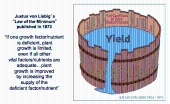
 2
2




 4
4




John Daley Bendigo, Australia The Enemy of progress is the hope of a perfect plan
Benefits of rainfall collection https://permies.com/t/88043/benefits-rainfall-collection
GOOD DEBT/ BAD DEBT https://permies.com/t/179218/mortgages-good-debt-bad-debt
 5
5



















 4
4




Country oriented nerd with primary interests in alternate energy in particular solar. Dabble in gardening, trees, cob, soil building and a host of others.
 7
7




 1
1




A human being should be able to change a diaper, plan an invasion, butcher a hog, conn a ship, design a building, write a sonnet, balance accounts, build a wall, set a bone, comfort the dying, take orders, give orders, cooperate, act alone, solve equations, analyze a new problem, pitch manure, program a computer, cook a tasty meal, fight efficiently, die gallantly. Specialization is for insects.
-Robert A. Heinlein






 1
1




Chris Kott wrote:I have another take, in the form of a question: If we artificially accelerate the growth of these plants, are we necessarily doing ourselves any favours from a nutrient density standpoint?
Taking the example of PNW yew in bowyery, the yew that is best for bows grows slowly, in the shaded understory of foothills, as I understand it. If you try to use coddled yew, grown with plenty of everything it needs, the grain isn't as dense as it needs to be.
It might be a slightly different phenomenon than what we see with growing food in inert or depleted media (lifeless soil, most hydroponics and sterile media growing), but if the plants are growing so fast that other processes responsible for their health and nutrient density can't keep up, we might be looking at a similar situation.
So what if, as with the coddled yew growing in one season what would take the shade-grown yew several, the fact that these plants are growing so much more in a single light cycle between rest periods compromises their nutritional value or gene expression?
It has often been speculated that hothouse-grown produce was nutrient deficient simply because the media being used were sterile. But what if there's more to it than that?
But to address the idea, people have burned candles and other fuel-burning appliances to afford CO2 and heat for their greenhouses for centuries, I would imagine. The idea is sound. My opinion on its application, though, is that it's a great solution for CO2 starvation in the greenhouse, but I would stick towards the high-end of normal outdoor C02 levels.
But good luck, please don't suffocate yourself or others, and keep us posted.
-CK
Country oriented nerd with primary interests in alternate energy in particular solar. Dabble in gardening, trees, cob, soil building and a host of others.
 1
1




A human being should be able to change a diaper, plan an invasion, butcher a hog, conn a ship, design a building, write a sonnet, balance accounts, build a wall, set a bone, comfort the dying, take orders, give orders, cooperate, act alone, solve equations, analyze a new problem, pitch manure, program a computer, cook a tasty meal, fight efficiently, die gallantly. Specialization is for insects.
-Robert A. Heinlein
 2
2




"You must be the change you want to see in the world." "First they ignore you, then they laugh at you, then they fight you, then you win." --Mahatma Gandhi
"Preach the Gospel always, and if necessary, use words." --Francis of Assisi.
"Family farms work when the whole family works the farm." -- Adam Klaus







 1
1














Phil Stevens wrote:It just happens that I know the guys that run the major grow business on the East Coast. I'll ask what they're doing. This whole line of inquiry came up because I met a couple people who design heat and CO2 enhancement systems for commercial growers and they're interested in biochar. So next I started thinking about RMH applications as well.
Country oriented nerd with primary interests in alternate energy in particular solar. Dabble in gardening, trees, cob, soil building and a host of others.




When in doubt, doubt the doubt.

|
This tiny ad is suggesting that maybe she should go play in traffic.
Rocket Mass Heater Resources Wiki
https://permies.com/w/rmh-resources
|






